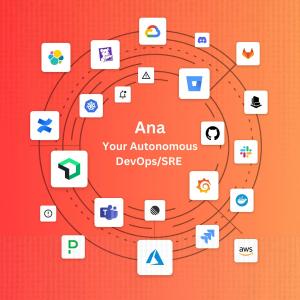OpenAna launches First Agentic Autonomous Engineer Transforming DevOps, SRE, and Cloud Operations
OpenAna introduces the first Autonomous Engineer for end-to-end DevOps, SRE, and cloud reliability beyond AI assistants and manual toil.
Ana operates across an integrated ecosystem—spanning observability, incident management, CI/CD, collaboration, infrastructure as code, and cloud providers—making it a dependable team member embedded within the stack, not just another tool.
Many enterprises are shifting from legacy operations that rely on manual scripts, alert-centric workflows, and siloed teams, toward platforms that support autonomous action, unified collaboration, and proactive reliability engineering. Ana is built for this shift, offering an agentic system that builds, scales, hardens, and remediates infrastructure without requiring human coordination.
With the growing complexity of digital infrastructure, organizations are increasingly embracing automation to maintain system uptime and developer productivity. According to Gartner, by 2025, 70% of enterprises will adopt AI-driven DevOps workflows, and over 80% of operations teams will require automation to maintain performance in hybrid environments. OpenAna’s latest release reflects this shift by expanding Ana’s core capabilities to include multi-agent task coordination, deep system context awareness, and dynamic remediation logic.
Unlike AI tools that assist with single-point tasks, Ana functions as an autonomous software engineer—able to understand, act, and execute across integrated enterprise systems. It proactively manages infrastructure provisioning, detects and resolves incidents, prevents drift, optimizes cost, and enforces compliance without relying on human intervention.
Key Enhancements Now Available in Ana
1. Autonomous SRE Operations – Performs full-cycle incident triage, RCA, and resolution across services and infrastructure.
2. Intelligent IaC Management – Dynamically generates and modifies Terraform, Helm, and Kubernetes configs based on system state.
3. Cloud & Infrastructure Automation – Controls resource provisioning, scaling, cost optimization, and secret rotation.
4. Incident-Aware Deployment Pipelines – Monitors CI/CD processes and applies real-time fixes or rollbacks to mitigate risks.
5. Built-in Compliance & Observability Controls – Maintains audit and telemetry alignment via integrations with Prometheus, OpenTelemetry, and cloud-native security tools.
6. Adaptive System Learning Engine – Builds institutional memory to prevent repeat failures and continuously improve reliability.
Why OpenAna’s Autonomous SRE/DevOps Engineer Stands Out?
Ana goes beyond DevOps toolchains and AI assistants. It serves as a platform-level Autonomous Engineer that takes action—not just surfaces insights. Ana works natively with dozens of enterprise systems (as shown in the integration visual) and continuously adapts to evolving infrastructure, policies, and codebases. It delivers impact across multi-cloud environments while supporting compliance frameworks like SOC2, HIPAA, and ISO.
Industry Impact: Case Examples
Retail Platform : Reduced cloud spend by 27% through real-time resource optimization and automated de-provisioning.
Financial Services Firm : Decreased change failure rate by 40% by halting faulty releases and initiating automated rollbacks.
Healthcare SaaS Vendor: Cut MTTR from hours to minutes using self-healing workflows for Kubernetes workloads.
Leadership Perspective
Rajiv Sondhi, CEO of OpenAna, commented "With increasing operational complexity, enterprises require more than AI-powered insights, they need fully autonomous solutions. Ana empowers DevOps and SRE teams to proactively manage infrastructure and resolve incidents, reducing manual workloads and improving overall system resilience."
Arsh Anwar, CTO of OpenAna, added:"AI is fundamentally reshaping DevOps and reliability engineering. Ana’s expanded capabilities ensure that enterprises can focus on innovation and scale, while trusting Ana to autonomously manage operational stability and compliance."
Future Roadmap for Ana
Advanced Root Cause Prediction – Detecting early warning signals and correlating them with architectural patterns.
Multi-Agent Task Swarming – Launching agent clusters to investigate, fix, and verify incidents across complex environments.
Extended API and Ecosystem Integrations – Including ServiceNow, OPA, and custom policy-as-code frameworks.
Learn More
For more information about Ana’s autonomous engineering platform and how it is transforming DevOps, SRE, and infrastructure operations, visit www.openana.ai or contact at hello@openana.ai
About OpenAna:
OpenAna is the creator of Ana, the industry's first truly autonomous engineer. Ana automates the full software operations lifecycle—from infrastructure and cloud optimization to reliability engineering and continuous compliance—helping enterprises reduce toil, enhance system resilience, and ship faster.
Rajiv Sondhi
OpenAna.ai
email us here
Legal Disclaimer:
EIN Presswire provides this news content "as is" without warranty of any kind. We do not accept any responsibility or liability for the accuracy, content, images, videos, licenses, completeness, legality, or reliability of the information contained in this article. If you have any complaints or copyright issues related to this article, kindly contact the author above.
Coolcaa 11'8 Anchor Wing ist Testsieger – Vielversprechender Neuzugang im SUP-Markt
From Aristocracy to Authenticity: Cook with a Real Duchess at Butera 28 Apartments in Palermo
Small Businesses Face Rising Threat of Fake Google Reviews Amid Growing Digital Trust Crisis
Więcej ważnych informacji
 Jedynka Newserii
Jedynka Newserii

 Jedynka Newserii
Jedynka Newserii

Ochrona środowiska

Kraje dotknięte powodzią z 2024 roku z dodatkowym wsparciem finansowym. Europosłowie wzywają do budowy w UE lepszego systemu reagowania na kryzysy
W lipcu Parlament Europejski przyjął wniosek o uruchomienie 280,7 mln euro z Funduszu Solidarności UE na wsparcie sześciu krajów dotkniętych niszczycielskimi powodziami w 2024 roku. Polska otrzyma z tego 76 mln euro, a środki mają zostać przeznaczone na naprawę infrastruktury czy miejsc dziedzictwa kulturowego. Nastroje polskich europosłów związane z funduszem są podzielone m.in. w kwestii tempa unijnej interwencji oraz związanej z nią biurokracji. Ich zdaniem w UE potrzebny jest lepszy system reagowania na sytuacje kryzysowe.
Handel
Nestlé w Polsce podsumowuje wpływ na krajową gospodarkę. Firma wygenerowała 0,6 proc. polskiego PKB [DEPESZA]

Działalność Nestlé w Polsce wsparła utrzymanie 45,2 tys. miejsc pracy i wygenerowała 20,1 mld zł wartości dodanej dla krajowej gospodarki. Firma przyczyniła się do zasilenia budżetu państwa kwotą 1,7 mld zł – wynika z „Raportu Wpływu Nestlé” w Polsce przygotowanego przez PwC na podstawie danych za 2023 rok.
Polityka
M. Kobosko: Surowce dziś rządzą światem i zdecydują o tym, kto wygra w XXI wieku. Zasoby Grenlandii w centrum zainteresowania

Duńska prezydencja w Radzie Unii Europejskiej rozpoczęła się 1 lipca pod hasłem „Silna Europa w zmieniającym się świecie”. Według zapowiedzi ma się ona skupiać m.in. na bezpieczeństwie militarnym i zielonej transformacji. Dla obu tych aspektów istotna jest kwestia niezależności w dostępie do surowców krytycznych. W tym kontekście coraz więcej mówi się o Grenlandii, autonomicznym terytorium zależnym Danii, bogatym w surowce naturalne i pierwiastki ziem rzadkich. Z tego właśnie powodu wyspa znalazła się w polu zainteresowania Donalda Trumpa.
Partner serwisu
Szkolenia

Akademia Newserii
Akademia Newserii to projekt, w ramach którego najlepsi polscy dziennikarze biznesowi, giełdowi oraz lifestylowi, a także szkoleniowcy z wieloletnim doświadczeniem dzielą się swoją wiedzą nt. pracy z mediami.

![Nestlé w Polsce podsumowuje wpływ na krajową gospodarkę. Firma wygenerowała 0,6 proc. polskiego PKB [DEPESZA]](https://www.newseria.pl/files/1097841585/fabryka-nesquik_1,w_85,r_png,_small.png)






.gif)

 |
| |
| |
|